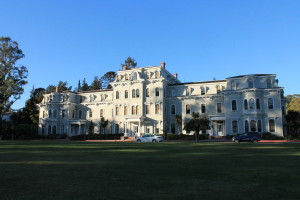
Science fiction slowly but surely becomes reality more and more each day with Clustered Regularly Interspaced Short Palindromic Repeats (CRISPR) editing being performed in the Mills College science department.
Established as a laboratory tool, in a 2012 publication, by biochemist from University of California Berkeley Jennifer Doudna, CRISPR-Cas9 (Cas9 being the primary enzyme in the gene-editing process) genome editing technique aims to one day use the technology to alter genes for human benefit in the fight against flawed genes and disease prevention and treatment.
Jared Young, Mills College associate professor of biology, explains that CRISPR is a naturally occurring immune system in bacteria; within the bacteria, a record of viruses that have affected the cell is kept within the DNA. When this is done, the bacteria can then recognize when repeating invading viruses return.
Willa Mankins, a senior biopsychology and English literature major, describes Cas-9 enzymes (RNA-guided DNA endonuclease enzyme) act as the spell-check for the genomic sequence within a cell.
“By scanning and cutting out incorrect sequences that could be harmful sections of DNA, the cell remains protected,” Mankins said.
CRISPR Cas-9 researchers take advantage of these naturally occurring processes and are able to direct the enzymes and cut specific genetic sequences. As a result, researchers are able to edit a cell’s DNA with great ease and accuracy.
Mills Alum Emily Jerome, a biopsychology major, is one of many students working in the lab performing research with the CRISPR-Cas9 technique. Jerome explains the potential of this tool in society.
“Of our current understandings, the [possible] applications of CRISPR-Cas9 are as endless as the power (weight of impact) of this tool,” Jerome said.
The CRISPR-Cas9 technique is being tested in labs all over the world because it is easier to prepare and work on the genes.

As of Oct. 12, it was reported that studies and research done at UC Berkeley have shown that CRISPR technology has had lasting effects on combating sickle cell disease through gene editing.
At Mills, these techniques are being performed on C.Elegans, a type of worm that thrives and survives off of bacteria. These see-through worms are used because they are a model organism, meaning: easy to raise, manipulate and have known characteristics (eg. Entire genome sequenced).
Mills students focus on the olfactory system, or sense of smell. Shayda Maher, biochemistry major, notes that studying the sense of smell is crucial when taking into consideration the human body’s other functions.
“We still do not know much about the olfactory system, but through our research we are able to understand the system in much more depth,” Maher said.
Mankins emphasizes the importance for labs to utilize the tool in specific and focused ways because of the technique’s endless research possibilities.
“[CRISPR-Cas9] went from ‘how does this process work’ to ‘how can we us it’; because of this the value of having an area of focus is key because options are limitless and its important that researchers have a goal in mind,” Mankins said.
With this new and influential research comes great responsibility. Young notes that this new technology has raised fear of it being used towards creating super soldiers and customizable offspring. At the International Summit on Human Gene Editing in Dec. 2015, lead researchers of the CRISPR technology came from the United States, United Kingdom and China to discuss the ethical implications of the technology.

Statements released from the conference provided ethical guidelines for researchers using the CRISPR technology and gave clear instructions, which stated that although preclinical research is crucial, to actually proceed with the clinical use of CRISPR would be irresponsible until safety and efficacy issues have been resolved and broad societal consensus have been reached.
Jerome discusses what could happen if this technology is to fall into the wrong hands and feels that, “everything in science can be used for good and bad.”
Despite the ethical hurdles that will someday need to be addressed, Young speaks highly of the CRISPR-Cas9 technology and reflects on the technology’s precision, efficiency and affordability.
“CRISPR is far better than anything we have ever had before and is such a huge step up in research in gene editing,” Young said.
Due to the technology’s importance, Young notes that students in his upper division Genetics classes will have the opportunity to use CRISPR-Cas9 within the classroom setting starting this semester. He also hopes to implement the technology within his Neurobiology courses in future semesters.




